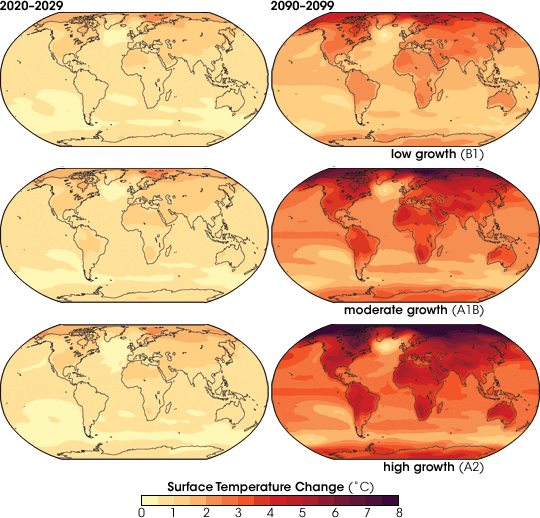“Temperature Shocks and Economic Growth” is the title of a new report released this month in the American Economic Journal: Macroeconomics. It is based on a study by a team of MIT, Harvard and Northwestern University researchers. Collecting temperature and economic output data for every year from 1950 through 2003, the team studied countries in the Developing and Developed World. The results showed a direct relationship between temperature rises, even temporary ones, and economic output.
It shouldn’t be a shock to correlate weather events with economic production. Hurricanes, droughts, heatwaves, blizzards, monsoons, tornadoes, hailstorms and other severe weather events are always disruptive. But for the first time, a study has been undertaken that shows the impact rising temperatures, even episodic ones, have on economic performance. And what is the nature of that impact?
- Declines in crop yields
- Changes from countries feeding themselves to becoming net importers of food
- Social unrest
- Mass migration
- Famine
- Inflationary pressures
- Political instability
- Lower industrial output
- Reduced capital for investment
- War
The findings are different for the Developed versus the Developing World. Although the former has felt the impact of rising temperatures the impact on economic growth has been negligible. That is not the result experienced by the latter. For them rising temperatures, increased evaporation, lower water tables and desertification in Sub-Saharan countries has led to significant economic disruption. Look at Nigeria, a country once self-sufficient in food today imports billion of dollars worth every year to feed its population.
Even in the Developed World we have witnessed dramatic weather events recently that are causing discernible economic fallout. The United Kingdom in 2012 has had monsoon-like weather that has destroyed local crops, disrupted dairy, poultry, pork and beef producers, and led to dismal economic forecasts. Surely this is a major contributing factor to the recent zero growth forecasts by the Bank of England and other financial analysts.
And what are the implications for North America’s economy from the current drought decimating farms throughout much of the continent? Prior to the drought existing economic forecasts for the United States showed growth of 2.4%. The states directly impacted by drought are now revising their numbers and predicting declines in their economic growth and those declines will percolate throughout the remainder of the U.S. economy.
Ultimately will the weather influence the 2012 Congressional and Presidential elections? Interestingly researchers found a correlation between political instability and rising annual temperatures. The data they collected for Developing World countries indicate that for every one degree Celsius (1.8 Fahrenheit) temperatures rise, instability in government increases by 3.1%. Can this also happen in the Developed World?
And one time weather events like the ones hitting the United Kingdom and North America this year will no doubt have a multiplier effect. They always have because when something bad happens it changes access to capital and investments in technology for a number of the years after.
Add Global Warming to the Mix and What Do You Get?
The Intergovernmental Panel on Climate Change (IPCC) is conservatively forecasting a temperature rise of 2 degrees Celsius (3.6 Fahrenheit) in this century. That’s a worldwide average with temperatures at the poles rising faster than temperatures at the equator, and temperatures rising the least over the mid-oceans.
In its most recent report, “Managing the Risks of Extreme Events and Disasters to Advance Climate Change Adaptation,” the IPCC points to evidence of increasing extreme weather events and an overall increase in the number of warm days and nights at a global scale. The study also reports a statistically significant trend in heavy precipitation events around the globe and projects with medium confidence more intense and longer droughts in drought prone areas. Interestingly the data indicates less frequent drought episodes in central North America and Australia. So this summer’s droughts on both continents may be anomalies. Neither North America or Australia are classified as part of the Developing World. They have the capacity to recover and even invest in technology to mitigate climate change. But for the Developing World fighting global warming will take more resources than these countries have available. It means an enormous human impact leading to economic losses, mass migration, famine, political unrest and potential conflict.










Enough data now exists to rationally suppose that average global temperature has increased a degree or two F over the last century, that atmospheric CO2 has increased about 30%, and that mankind’s burning of fossil fuels is a major influence in the additional CO2.
For the sake of discussion I will stipulate that human activity is entirely responsible for a global climate is 2-degrees warmer. That is to say the global climate has warmed as the hominid population has rapidly grown from well less than 2-billion to over 7-billion. See graph: http://en.wikipedia.org/wiki/File:World-Population-1800-2100.svg
Notice that in 1960 the world population curve adopted a 60° slope upwards, which continues without change right up to 2013. Should be obvious that major changes in population and moderate changes in climate require major changes in economic practice.
But climate and population can change more rapidly than political institutions and economic systems can change to optimize exploitation of the new conditions. More rain and longer growing seasons in Siberia and Canada allow more agricultural production there, while less rain in the tropics reduces agricultural production in the tropics. Conditions that might bring surplus to one region might bring famine to another. The fair question is whether you think it moral or wise to increase total global agricultural production by changing the climate so that the location of the production shifts from one region to another? To put the question another way, what is the optimum average global temperature? How could one answer that question without first answering: What is the optimum population level?
So while it seems likely global hominid population pressures are causing global warming, it seems unlikely anyone with serious political policy influence outside of China is going to stand up to honestly answer the three main questions, and then advocate the only possible measure that might reverse the warming trend: drastic population reduction. China now answers the three questions: “The optimum temperature is higher than it is now. It’s perfectly moral to increase total agricultural (and industrial) production regardless of economic displacements. The optimum hominid population is 1.3 Billion Chinese.” China is telling the world community, “We got our population under control, and now we are going to burn our fair share of coal.”
If the Western nations cannot give or show China and India a technology for power generation that is more economical than coal, they better prepare for ever-growing climate change displacements. Third world nations will just have to join the Devil in taking the hindmost.
Land that currently is not used for agriculture in places like Siberia and Canada may never be suitable for intensive cultivation. That is one of the problems that accompanies shifting biomes. It takes years before there is sufficient biomass on the ground for farming with any kind of reasonable yield. In Canada in particular the Canadian Shield is mostly barren rock with small pockets of very poor soils, suboptimal grey podzolic. So I don’t agree that automatically surpluses will be transferred from one area such as the tropics to more temperate climes in both the northern and southern hemispheres.
I do agree that the best answer to human induced climate change is to reduce human population but at the same time finding economical, renewable, marketable alternatives to coal and other CO2 producing forms of energy. That’s where countries and energy companies should be spending their dollars because there are too many questions that we have yet to answer about climate change consequences.